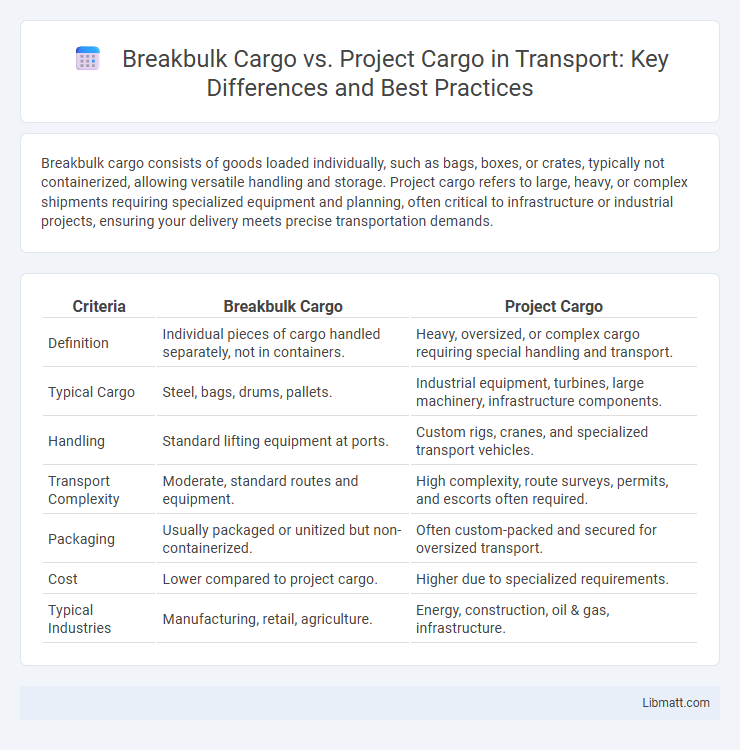Breakbulk cargo consists of goods loaded individually, such as bags, boxes, or crates, typically not containerized, allowing versatile handling and storage. Project cargo refers to large, heavy, or complex shipments requiring specialized equipment and planning, often critical to infrastructure or industrial projects, ensuring your delivery meets precise transportation demands.
Table of Comparison
| Criteria | Breakbulk Cargo | Project Cargo |
|---|---|---|
| Definition | Individual pieces of cargo handled separately, not in containers. | Heavy, oversized, or complex cargo requiring special handling and transport. |
| Typical Cargo | Steel, bags, drums, pallets. | Industrial equipment, turbines, large machinery, infrastructure components. |
| Handling | Standard lifting equipment at ports. | Custom rigs, cranes, and specialized transport vehicles. |
| Transport Complexity | Moderate, standard routes and equipment. | High complexity, route surveys, permits, and escorts often required. |
| Packaging | Usually packaged or unitized but non-containerized. | Often custom-packed and secured for oversized transport. |
| Cost | Lower compared to project cargo. | Higher due to specialized requirements. |
| Typical Industries | Manufacturing, retail, agriculture. | Energy, construction, oil & gas, infrastructure. |
Introduction to Breakbulk and Project Cargo
Breakbulk cargo consists of goods that are transported in individual pieces, such as machinery, steel coils, or pallets, rather than in containers, making it suitable for shipments that exceed standard container dimensions. Project cargo involves the transportation of large, heavy, or complex pieces of equipment critical to major industrial ventures, often requiring specialized handling, route surveys, and coordination. Understanding the differences in handling, logistics, and planning between breakbulk and project cargo is essential for optimizing the shipping of oversized or heavy cargo tailored to Your specific project needs.
Defining Breakbulk Cargo
Breakbulk cargo consists of goods transported in individual pieces or units, such as bags, drums, crates, or pallets, rather than in containers or bulk shipments. These items are typically loaded and unloaded separately, requiring specialized handling equipment and logistics planning. Unlike project cargo, which includes oversized or heavy shipments for specific projects, breakbulk cargo often involves standard-sized goods that do not fit container dimensions but are not necessarily oversized.
What is Project Cargo?
Project cargo refers to the transportation of large, heavy, high-value, or complex pieces of equipment and materials essential for specific industrial projects like construction, oil and gas, or renewable energy. This cargo requires specialized handling, custom packaging, and detailed logistical planning to ensure safe and timely delivery to often remote or challenging locations. Unlike standard breakbulk cargo, project cargo involves coordinated multi-modal transport with precise scheduling to meet project timelines.
Key Differences Between Breakbulk and Project Cargo
Breakbulk cargo consists of goods loaded individually, such as bags, drums, or pallets, often used for general cargo that does not fit container shipping, while project cargo involves large, complex, or heavy items requiring specialized handling and logistics solutions. Key differences include the scale and complexity of shipment, with project cargo often involving engineered transport plans, heavy-lift equipment, and route surveys compared to the simpler handling of breakbulk shipments. Project cargo typically supports industries like oil, gas, and construction, whereas breakbulk cargo serves a broader range of general merchandise and industrial goods.
Types of Goods Handled
Breakbulk cargo primarily involves individually packaged goods such as bags, drums, pallets, or crates that are typically loaded and unloaded manually or with forklifts. Project cargo consists of oversized, heavy, or complex shipments like machinery, industrial equipment, and large components requiring special handling, rigging, and transport solutions. Your choice between these types depends on the specific nature of the goods and the logistical requirements for safe, efficient delivery.
Typical Industries Served
Breakbulk cargo mainly serves industries such as steel, machinery, and paper, where goods are shipped as individual pieces or units. Project cargo is tailored for sectors like oil and gas, energy, and construction, involving the transport of large, complex, and heavy components that require specialized handling. Your supply chain benefits from understanding these distinctions to optimize logistics strategies for each industry's unique requirements.
Specialized Equipment and Handling Requirements
Breakbulk cargo involves individually loaded items such as bags, boxes, or drums that require standard handling equipment like forklifts and cranes. Project cargo encompasses oversized, heavy, or complex shipments demanding specialized handling gear including heavy-lift cranes, hydraulic trailers, and modular transport systems to navigate challenging routes. Your choice between these cargo types depends on the specific equipment capabilities and expertise needed to safely manage and transport the goods.
Logistics Challenges and Solutions
Breakbulk cargo logistics face challenges such as handling diverse, irregularly shaped shipments that require specialized equipment and careful stowage to prevent damage, while project cargo involves oversized, heavy components necessitating detailed route planning, permits, and heavy-lift transport solutions. Solutions for breakbulk logistics include modular loading systems and enhanced tracking technologies, whereas project cargo requires integrated project management, customized cradle supports, and collaboration with local authorities to ensure smooth transit. Efficient coordination between multimodal transport modes and real-time monitoring systems mitigate risks and optimize delivery timelines for both cargo types.
Cost Considerations and Pricing Structures
Breakbulk cargo typically incurs lower handling costs due to standardized packaging and loading procedures, whereas project cargo demands higher expenses from specialized equipment, custom permits, and route surveys. Pricing structures for breakbulk emphasize weight and volume metrics, while project cargo pricing accounts for complexity, risk factors, and tailored logistics planning. Your choice impacts budgeting, with project cargo requiring a premium to ensure safe and compliant delivery of oversized or heavy components.
Choosing the Right Cargo Solution for Your Needs
Breakbulk cargo typically involves individually loaded items such as machinery or steel beams that do not fit into standard containers, while project cargo refers to large, complex shipments requiring specialized handling and planning, such as oversized industrial components. Selecting the right cargo solution depends on the size, weight, and special handling requirements of your shipment, ensuring efficient transport and minimizing risks. Understanding these differences allows you to optimize logistics strategies tailored to your specific project demands.
breakbulk cargo vs project cargo Infographic

 libmatt.com
libmatt.com